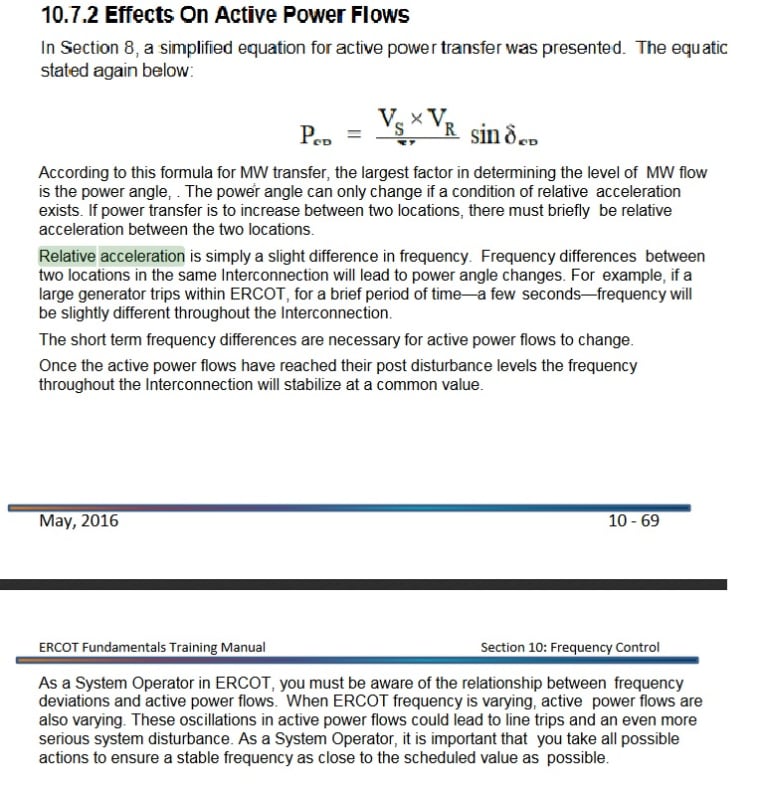Ok, yes, somewhat provocative, but for a good reason...
Measurement definitions and techniques matter. There have been a lot of absolutest statements about a single frequency on any system of any size without any definition of how that is determined. There are valid definitions that could make that true under essentially all conditions. There are other, equally valid definitions, such as how relays measure frequency, for which that isn't true.
On a system of sufficient size steady state doesn't exist, at least under certain reasonable definitions. If you were to inquire of every line relay in WECC what the system frequency was you'd get a smear, not a point, nor a scatter plot. The smear is a tight grouping of different values, a scatter plot would allow observation of multiple distinct points. To give the smear/dot/scatter plot two dimensions plot df/dt vs. f.
On reasonably sized systems the smear is so small that it can't be distinguished from a point. On larger systems there's always so much variation that it can never be close to looking like a point.
There's an awful lot of running generation that doesn't have any governor response. Run of the river hydro is run based on water flow and ignores system frequency. A lot of base-load generation is run at constant MW output regardless of frequency. Wind and PV just do their own thing and don't give a whit about any needs of the larger system, they just want some, any, system frequency to track. Those units paid to have governor response are the ones to respond to system frequency deviations; the dispersion of governed units is not uniform across the system. Keep in mind, I'm referring to a 150GW (yes GW) system that includes over 121,000 miles of transmission line. Small, islanded, systems need every unit to be governed but on the big system most aren't.
System frequencies, within a tight but ever shifting band, are always tending toward the same value. But different parts of the system are doing different things, some places df/dt is positive and other places df/dt is negative at the same instant. If I plot our system frequency for the past week I get a very wide, very fuzzy "line" that pretty much shades in the whole band between 59.98 and 60.02 with lots of excursions to and beyond 59.96 and 60.04. But if I plot that on a scale from 0 to 100 I see a line that has an occasional pixel that deviates from a straight line right at 60.
There can be no standing differences in frequency, I've never meant to imply that, but (using a relay definition of frequency anyway) there's also not a single frequency everywhere at all times. At least not one that would plot as a nice, neat, dot.
Using definitions other than what the relays do, to measure frequency it might well all be the same frequency. But if the relays all, system wide, always measured the same frequency the approach to under frequency load shedding would have to be very different than what it is.
Same frequency with different phase angles or different frequencies - it's just different paths from the same starting point to the same ending point, all within well defined constraints. A 50ft view vs. a 35000ft view. Just define the criteria.
If you're looking at motor speed at various locations it is certainly one one frequency. If you're analyzing an underfrequency load shedding scheme it's a multitude of frequencies at a multitude of locations. Plot them all and you get that same smear.
The truth isn't dogmatic, but rather pragmatic. Statements that can't be proven to be anything other than true at certain system scales don't hold as well at much larger scales. Einstein proved Newton "wrong" but Newton still gives perfectly good answers within most conditions. Similarly, within lots of systems "one frequency everywhere" is an accurate answer to any degree of precision possible, but that doesn't mean that it still scales to major interconnect levels.
Sure, at steady state it's all one frequency everywhere, but eventually the system is too large to have a steady state. The major interconnects fall into that too large for steady state category.

